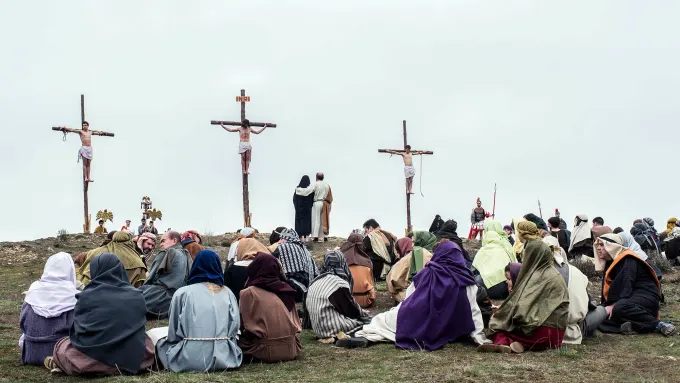Good Friday, observed the Friday before Easter Sunday, holds deep meaning for Christians across the world. It marks the crucifixion and death of Jesus Christ at a place called Calvary. This solemn day is recognized under various names including Holy Friday, Great Friday, and even Black Friday in some traditions, all underscoring its significance in the Christian calendar.
For those who follow the Christian faith, Good Friday is not just a memorial of sorrow, but a pivotal moment in the divine story of redemption. It commemorates the events that Christians believe changed the course of history forever. Jesus’ death and resurrection are seen as the foundation of Christian faith, and the weekend starting with Good Friday and ending with Easter Sunday is often regarded as the most important in the Christian year.
In the New Testament, the apostle Paul emphasized the central importance of these events. He wrote that Christ’s death, burial, and resurrection happened just as foretold in the Scriptures, and that this truth is of “first importance” (1 Corinthians 15:3-4). This underlines the Christian belief that Jesus’ sacrifice wasn’t random or accidental—it was the fulfillment of God’s long-established plan to redeem humanity.
Why Call It “Good” Friday?
At first glance, calling the day of Jesus’ execution “Good” may seem strange. After all, it was a day of tremendous suffering, betrayal, and grief. Some languages refer to it differently—for instance, in German, it’s called “Karfreitag,” which means “Sorrowful Friday.” But in English, the term “Good” is thought to derive from “God’s Friday,” or simply to refer to the holiness and redemptive power of what happened that day.
From a Christian perspective, the “goodness” of Good Friday lies not in the pain and suffering itself, but in what it accomplished. Jesus’ death was the ultimate act of love and obedience, serving as the final atonement for sin. Through this one sacrificial act, the way was opened for reconciliation between humanity and God. Without the pain of the cross, the joy of Easter—the celebration of Christ’s resurrection—would not be possible.
Good Friday forces Christians to confront the darker side of the human story: sin, brokenness, betrayal, and the consequences of turning away from God. But it also illuminates God’s overwhelming grace and mercy. The cross represents the meeting point of divine justice and compassion. As written in Psalm 85:10, “righteousness and peace kiss each other”—a poetic foreshadowing of the harmony achieved through Jesus’ sacrifice.
The Biblical Narrative of Good Friday
The story of Good Friday is detailed in all four Gospels: Matthew, Mark, Luke, and John. It begins after Jesus shares a final meal—what is now known as the Last Supper—with His disciples. Following that evening, Jesus is arrested in the Garden of Gethsemane. He is betrayed by Judas Iscariot and brought before Jewish religious leaders and then to the Roman governor, Pontius Pilate.

Though Pilate found no guilt in Jesus deserving death, public pressure and political convenience led to Jesus being sentenced to crucifixion. The people chose to free Barabbas, a known rebel, instead of Jesus. He was beaten, mocked, and led away to be crucified.
At a site called Golgotha—translated as “The Place of the Skull”—Jesus was nailed to a cross between two criminals. Above His head, a sign read: “This is Jesus, King of the Jews.” Bystanders mocked Him, questioning His divinity and daring Him to save Himself. Even as He hung in agony, Jesus spoke words of forgiveness and compassion, showing mercy even to the criminal beside Him and praying for His persecutors.
Around noon, the sky grew dark, and remained so until mid-afternoon. Jesus cried out, “My God, my God, why have you forsaken me?”—a powerful expression of His humanity and the weight of bearing the world’s sin. Shortly after, He declared, “It is finished,” and breathed His last.
At that moment, dramatic signs occurred: the earth trembled, rocks split, and the veil in the temple—a thick curtain separating the Holy of Holies—was torn in two. This symbolized the breaking of the barrier between God and humanity. A Roman centurion, witnessing these events, proclaimed, “Surely he was the Son of God!”
The Fulfillment of Prophecy
The events of Good Friday are often viewed by Christians as the fulfillment of Old Testament prophecies, particularly those found in the book of Isaiah. Written centuries before Christ’s birth, Isaiah 53 describes a suffering servant who would bear the sins of many. “He was pierced for our transgressions… by His wounds we are healed.” For believers, this passage speaks directly to the mission of Jesus and His willingness to suffer for others’ sake.
Similarly, 1 Peter 2:24 echoes this idea: “He himself bore our sins in His body on the tree, that we might die to sin and live to righteousness.” Good Friday is, therefore, not only a historical remembrance but a spiritual truth being lived out in the lives of believers every day.
The Deeper Meaning of the Cross
The cross stands at the heart of Christian theology, not as a symbol of defeat, but of victory. Through His suffering and death, Jesus bridged the divide caused by sin. The punishment that was due to humanity was taken upon Himself. Romans 5:8 affirms, “But God demonstrates His own love for us in this: While we were still sinners, Christ died for us.”
Thus, Good Friday is a day to reflect deeply on grace, mercy, and divine love. It reminds believers that salvation came at a cost—an immeasurable cost—and it invites a response of gratitude and devotion.
Observing Good Friday Today
Good Friday is typically observed with solemnity and reverence. Across Christian denominations, services are held to reflect on Jesus’ passion and death. These services may include Scripture readings, sermons, silent reflection, and the singing of hymns that express sorrow, reverence, and hope.
Fasting is also a traditional practice on Good Friday. Many Christians abstain from food or limit their meals, dedicating the day to prayer and contemplation. The idea is to identify in some small way with Christ’s suffering and to strip away distractions in order to focus more fully on God.
In some traditions, particularly Eastern Orthodox and Byzantine Catholic churches, the Holy Shroud—an embroidered cloth representing Christ’s burial—is ceremonially brought out and placed in the center of the church. Surrounded by flowers and incense, this act symbolizes both mourning and honor.

Between noon and 3 p.m.—the hours Jesus is believed to have hung on the cross—many churches hold special services or moments of silence. Some Christians choose to meditate during these hours, contemplating the seven last sayings of Christ or reading the Gospel accounts of the crucifixion.
Hope Beyond the Cross
Despite its somber tone, Good Friday ultimately points to hope. Christians believe that death was not the end of Jesus’ story. His resurrection on Easter Sunday affirms His victory over death and His power to offer eternal life to all who believe in Him.
John 3:16 expresses this hope clearly: “For God so loved the world, that He gave His only Son, that whoever believes in Him should not perish but have eternal life.” Good Friday, then, is not the conclusion but the turning point—a prelude to resurrection and renewal.
It’s a day that urges Christians to look inward, to confess and turn away from sin, and to look upward in faith, trusting in God’s redemptive plan. In a world often filled with brokenness and pain, the message of Good Friday remains profoundly relevant. It tells of a God who is not distant or indifferent, but one who steps into human suffering, offering love and forgiveness.
Final Reflections
Good Friday invites Christians to remember and respond. It calls for quiet reflection, sincere repentance, and renewed commitment. It challenges believers to live in the light of the cross—not with despair, but with gratitude and hope.
As we reflect on the passion of Christ, we are reminded not just of what Jesus endured, but why He endured it: out of love for humanity and a desire to restore what was lost. It is a day marked by grief, but also by grace.
Through the cross, death has been defeated, and a path has been made clear—forgiveness, renewal, and everlasting life.




